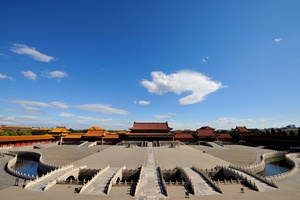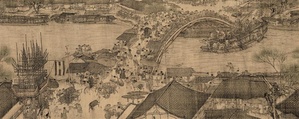Area
The Palace Museum in Beijing is one of the four major museums in China and is by far the largest museum of ancient culture and art in China in terms of area. It is located in the center of Beijing's central axis, 753 meters wide from east to west and 961 meters long from north to south, occupying a land area of 720,000 square meters and a building area of about 150,000 square meters. In general, it consists of more than 9,000 rooms and spread over 250 acres. It was established on October 10, 1925 and is located within the Forbidden City of the Forbidden City in Beijing. It is a comprehensive museum in China based on the imperial palaces and their collections of the Ming and Qing dynasties, and is also the largest museum of ancient culture and art in China. Its collection of cultural relics mainly comes from the old palace collections of the Qing dynasty, but is not limited to the Ming and Qing dynasties, for example, the "Along the River During the Qingming Festival" (清明上河图) from the Song dynasty is included.
 The picture comes from the official website of The Palace Museum. https://en.dpm.org.cn/about/about-museum/
The picture comes from the official website of The Palace Museum. https://en.dpm.org.cn/about/about-museum/
 The picture comes from Shine by Peter Zhang (2017). https://www.shine.cn/feature/art-culture/1710185102/
The picture comes from Shine by Peter Zhang (2017). https://www.shine.cn/feature/art-culture/1710185102/
Location
The Palace Museum is located in the heart of Beijing, accessible through Tiananmen Square. Immediately north of the Palace Museum is Prospect Hill (also known as Coal Hill), while to the east and west are the Wangfujing and Zhongnanhai neighborhoods. The Palace was the residence and court of twenty-four emperors during its nearly five hundred years of imperial operation. The Forbidden City is surrounded by 10-meter-high walls and a 52-meter-wide moat. Each side of the rectangular city has a gate. The four gates are the Ziwu Gate on the south, the Shenwu Gate on the north, and the Prosperity Gate on the east and west.
 The picture comes from the official website of The Palace Museum. https://en.dpm.org.cn/about/about-museum/
The picture comes from the official website of The Palace Museum. https://en.dpm.org.cn/about/about-museum/
History
The Forbidden City was the imperial palace of China's Ming and Qing dynasties (1368-1911 AD). After the third emperor of the Ming Dynasty, Zhu Di, decided to move the capital to Beijing, so the palace was built in 1406 A.D. and completed in 1420 A.D., the 18th year of Ming Yongle (Yongle Emperor). After the Ming and Qing dynasties, the last emperor of the Qing dynasty was expelled from the Forbidden City in 1924 with the outbreak of the Xinhai Revolution in 1911 and the overthrow of the Qing dynasty, China's last feudal empire.
After the victory of the Xinhai Revolution in 1911, the Qing government announced its abdication and the palace should have been nationalized, but Pu Yi was still allowed to live in the Forbidden City. Through 1924 Feng Yuxiang launched the "Beijing coup", while organizing the cabinet system, modified the conditions of preferential treatment for the Qing royal family, expelled Pu Yi from the palace and took over the Forbidden City. 29 September 1925, with the "temporary organization of the Palace Museum outline" adopted, the committee began to inventory the cultural relics in the Palace, and organize.
Collections
Before the establishment of the National Palace Museum, Emperor Pu Yi has been about 200 pieces of fine paintings and calligraphy and a large number of treasures shipped out of the National Palace. In 1933 with the sudden change of situation in North China, so the National Government issued an order to move the cultural relics of the Forbidden City to the south, when a total of 13,491 boxes. However, with some of the cultural relics moved south, the Forbidden City in Beijing also still has a considerable number of treasures.
According to the 1925 publication of the Qing dynasty aftercare committee point check report, there are more than one hundred and seventeen thousand pieces of cultural relics left behind by the Palace, including bronze, jade, paintings and calligraphy, ceramics, enamelware, lacquerware, gold and silverware, in addition, there are a large number of books, canonical books, documents, archives, etc.
Importance of The Palace Museum
Since January 1, 2014, the Beijing Palace Museum has been closed almost every Monday. The Beijing Palace Museum is located in the Imperial Palace of Beijing. The Beijing Palace is the first batch of national key cultural relics protection units, the first batch of national 5A tourist attractions, and was selected for the World Cultural Heritage List in 1987. The drafting, maintenance and development of the Palace Museum during the Republican period coincided with the transformation process of China from traditional culture in the imperial era to modern culture in the nation-state, and the historical memory carried and the cultural identity reflected in this history is very rich and profound. At the same time, the Palace Museum is a powerful memory site and imaginary space in modern society, carrying the history and culture of the nation and the country, linking the past, present and future. Thus, the Palace Museum have a special significance in shaping the collective memory and identity of social groups.
From the historical dynasties of cultural relics, the most important feature of the Forbidden City collection is "continuity", for example, from the ancient civilization relics excavated from sites 5,000 years ago, fragments to prove the existence of the official kilns, to 3,000 years ago ritual bronze, to modern ceramics and jade, books, literature, paintings and calligraphy, and astronomical instruments indicating the development of modern science and technology, to show the royal life of the palace relics, the Forbidden City in Beijing have a rich collection.
References
The Palace Museum. (n.d.). About the Palace Museum. The Palace Museum. https://en.dpm.org.cn/about/about-museum/
Zhang. P. (2017). Along the River During the Qingming Festival. Shine. https://www.shine.cn/feature/art-culture/1710185102/


